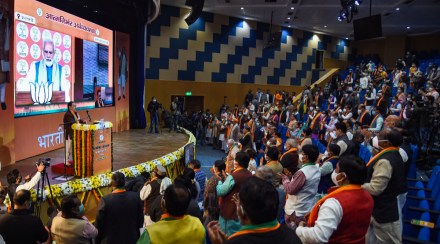At 6 pm today, the poll campaign for the first phase of the Uttar Pradesh Elections will come to a halt. This year, due to the raging Omicron wave, the Election Commission had banned the physical rallies and other ways of canvassing. Though the Covid situation has improved now, certain pandemic curbs still remain in place. Hence, the run-up to the Uttar Pradesh Assembly Elections 2022 has seen the use of more new-age ways of connecting with the voters. While electronic media and digital outreach have been part of political parties action plan, an almost absolute halt on the on-ground campaigning in January forced leaders to ramp up their online game.
Advantage BJP?
Ruling BJP seemed to have an upper hand in the online poll campaigning, which was highlighted by Samajwadi Party’s chief Akhilesh Yadav. Back in January, soon after the Election Commission’s ban, Yadav had said that BJP has formidable ‘digital infrastructure’. He had also asked the poll panel to provide funds to other parties to ‘compete’ with the BJP in the online world.
Webinars, virtually rallies and more
So what exactly did BJP do in the first phase of digital campaigning? Talking to the Financial Express Online, BJP’s Noida media in-charge Tanmay Shankar said that it was both ‘exciting and challenging’ for the party to work with the Election Commission’s strict Covid guidelines. He said the BJP was already well-equipped with digital systems. Citing the first and the second Covid waves, Shankar said that the BJP functionaries had worked in a virtual setup and hence knew what to do.
Also Read: Uttar Pradesh Assembly Election 2022 Samajwadi Party-SBSP-RLD Full Candidate List
Offering an insight into the BJP’s digital strategy, Shankar said that for Phase 1, Noida was divided into eight ‘mandals’ and further subdivided into sectors and booth levels. Each booth has a dedicated WhatsApp group. ‘Last mile coverage is what BJP is doing,’ Shankar added.
Also read: FE Exclusive | Casteism a blot on UP, AAP here to challenge it this election: Sanjay Singh
On other parties’ lack of understanding of the online world, Shankar said that “if you look at other parties’ war rooms, you would realise that they don’t have any understanding of the online strategy. They don’t know how to tackle the situation.”
RSS and door-to-door campaign
Another aspect of the campaign is the ‘we-won’t-take-name’ campaign by the RSS. Ground workers of the RSS have been undertaking door-to-door campaigns, where with folded hands and a ‘Jai Shri Ram’ chant, they hand over the pamphlet exhorting voters to vote in favour of ‘rashtra hit’ or ‘national interest’. On why the RSS doesn’t name the BJP during such door-to-door drives, Shankar, who has also worked with the organisation, says that the RSS is a social organisation. “They are asking you to vote for the nation because they work for everyone. Yes, the RSS is the ideological mentor of the BJP, but you must look at the social aspect and not just politicise it.”
Digital space: What numbers say
This year, the Indian social media space has seen a flurry of unique interactive activities by political leaders. From Prime Minister Narendra Modi’s ‘Jan Chaupal’ to Priyanka Gandhi Vadra’s Facebook Lives to AAP’s viral video tweets, parties have realised how critical social media is. FE BrandWagon Online reports that according to an iCubesWire study, around 1/3rd of the respondents said that they consume political news or follow such topics on Facebook. Nearly 70 per cent of the participants say that they interacted with the politicians on social media. A staggering 80 per cent are okay with political advertising on social media.
